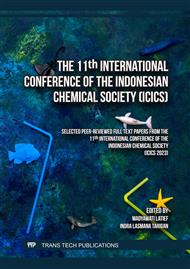[1]
WHO. Dengue - Global situation. 2024.
Google Scholar
[2]
Grobusch MP, Niedrig M, Go K, Teichmann D, Clinic M. Research note. 2006;395–7.
Google Scholar
[3]
Marimuthu S, Rahuman AA, Rajakumar G, Santhoshkumar T, Kirthi AV, Jayaseelan C, et al. Evaluation of green synthesized silver nanoparticles against parasites. Parasitol Res. 2011; 108(6): 1541–9
DOI: 10.1007/s00436-010-2212-4
Google Scholar
[4]
Abdallah HM, Mohamed GA, Ibrahim SRM. Lansium domesticum—A Fruit with Multi-Benefits: Traditional Uses, Phytochemicals, Nutritional Value, and Bioactivities. Nutrients. 2022; 14(7):1–42
DOI: 10.3390/nu14071531
Google Scholar
[5]
Techavuthiporn C. Langsat— Lansium domesticum. Exotic Fruits. Elsevier Inc.; 2018. 279–283 p
DOI: 10.1016/b978-0-12-803138-4.00036-8
Google Scholar
[6]
Shankar S, Jaiswal L, Aparna RSL, Vara Prasad RGS, Kumar GP, Manohara CM. Wound healing potential of green synthesized silver nanoparticles prepared from Lansium domesticum fruit peel extract. Mater Express. 2015;5(2):159–64
DOI: 10.1166/mex.2015.1225
Google Scholar
[7]
Subahar R, Aulung A, Winita R, Susanto L, Lubis NS, Firmansyah NE, et al. Effects of Lansium domesticum leaf extract on mortality, morphology, and histopathology of Aedes aegypti larvae (Diptera: Culicidae). Int J Mosq Res. 2020;7(4):105–11. Available from: https://www.dipterajournal.com/pdf/2020/vol7issue4/PartB/7-4-6-606.pdf
Google Scholar
[8]
Yunus R, Rosanty A, Orno TG, Hasan E. Phytochemical analysis , Reppelant and Larvacide test of Lansium domesticum against Dengue Hemmoragic Fever Vector. :70–84.
Google Scholar
[9]
Octaviana D, Nurlaela S, Anandari D, Yanuar Pradani F. Lansium Domesticum Corr. Leaf Exstrak Spray As Bioinsecticide For Aedes Aegypti Mosquito Control. Int J Public Heal Clin Sci. 2020;7(2):51–9. Available from:
Google Scholar
[10]
Safni, Rahmiana Zein, Reza audina putri D. Advancement in Green Synthesis of Titanium Dioxide: Photocatalytic and Larvicidal Activities – A review. Hydrogen. 2024; 12 (February): 115–26.
DOI: 10.33394/hjkk.v12i1.10655
Google Scholar
[11]
Murugesan R, Vasuki K, Kaleeswaran B. A green alternative: Evaluation of Solanum torvum (Sw.) leaf extract for control of Aedes aegypti (L.) and its molecular docking potential. Intell Pharm. 2024;2(2):251–62
DOI: 10.1016/j.ipha.2023.11.012
Google Scholar
[12]
Gupta M, Gupta D. Essential oils: As Potential Larvicides. J Drug Deliv Ther. 2022; 12(3):193–201
DOI: 10.22270/jddt.v12i3.5313
Google Scholar
[13]
Shin J, Lee JW, Seo SM, Hyun J, Park IK. Larvicidal activities of Cnidium officinale Makino extract encapsulated with cellulose nanocrystal-stabilized Pickering emulsion against Aedes albopictus Skuse, a vector of Zika virus. Ind Crops Prod. 2023;204(PA):117263
DOI: 10.1016/j.indcrop.2023.117263
Google Scholar
[14]
Ghosh T, Saha S, Dutta A, Parida S, Mondal M, Khalua RK. Plant extracts in controlling disease vector mosquitoes. Int J Mosq Res. 2024; 11 (1): 89–91
DOI: 10.22271/23487941.2024.v11.i1b.747
Google Scholar
[15]
Ramayanti I, Febriani R. Uji Efektivitas Larvasida Ekstrak Daun Pepaya (Carica papaya Linn) terhadap Larva Aedes aegypti Pendahuluan Nyamuk yang ada . Spesies ini dapat ditemukan aegypti di Indonesia . Bisa dikatakan sebagai yang telah resisten , salah satunya Metode Penelitian. Syifa'MEDIKA. 2016;6(2):79–88.
DOI: 10.32502/sm.v6i2.1383
Google Scholar
[16]
Hadi Vania Armilda L. Systematic literature review: Potensi Tanaman Genus Syzygium sebagai larvasida Aedes aegypti. (2023)
Google Scholar
[17]
Ishak NI, Kasman, Chandra. Effectiveness of Lime Skin Extract (Citrus Amblycarpa) as Natural Larvacide Aedes Aegypti Instar III. Media Kesehat Masy Indones. 2019;15(3):302–10
DOI: 10.30597/mkmi.v15i3.6533
Google Scholar
[18]
N SA, I S, I S. Efektifitas Ekstrak Etanol Serai Wangi (Cymbopogon Nardus L) Sebagai Larvasida Aedes Aegypti. E-Jurnal Med Udayana. 2017;6(1):1–4.
DOI: 10.35799/jbl.10.1.2020.26920
Google Scholar
[19]
Balaraman P, Balasubramanian B, Liu W. Sargassum myriocystum- mediated TiO2 -nanoparticles and their antimicrobial, larvicidal activities and enhanced photocatalytic degradation of various dyes. 2022; 204(September 2021).
DOI: 10.1016/j.envres.2021.112278
Google Scholar
[20]
Narayanan M, Vigneshwari P, Natarajan D. Synthesis and characterization of TiO2 NPs by aqueous leaf extract of Coleus aromaticus and assess their antibacterial , larvicidal , and anticancer potential. Environ Res. 2021;200(April):111335. https://doi.org/10.1016/j.envres. 2021.111335
DOI: 10.1016/j.envres.2021.111335
Google Scholar
[21]
Soni N, Dhiman RC. Larvicidal activity of Zinc oxide and titanium dioxide nanoparticles Synthesis using Cuscuta reflexa extract against malaria vector (Anopheles stephensi). Egypt J Basic Appl Sci. 2020;7(1):342–52
DOI: 10.1080/2314808X.2020.1830236
Google Scholar
[22]
Sundrarajan M, Bama K, Bhavani M, Jegatheeswaran S, Ambika S, Sangili A, et al. Obtaining titanium dioxide nanoparticles with spherical shape and antimicrobial properties using M. citrifolia leaves extract by hydrothermal method. J Photochem Photobiol B Biol. 2017; 171 (February): 117–24
DOI: 10.1016/j.jphotobiol.2017.05.003
Google Scholar


